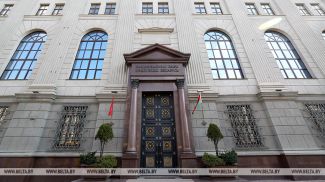MINSK, 24 November (BelTA) – The National Bank of the Republic of Belarus (NBRB) believes it is necessary to transition to inflation targeting fast, BelTA learned from Head of the NBRB's Research and Strategic Development Office Natalya Mironchik at a roundtable session on 24 November.
The official said: “Considering the best world experience, we believe we should enable all the conditions as soon as possible and transition to inflation targeting in order to stabilize inflation and secure the basic fundamental conditions for increasing the potential for economic growth. Inflation targeting will help reduce inflation, stabilize inflation expectations, and build up trust in the Belarusian ruble.”
In her words, some of the necessary conditions have already been enabled. Securing price stability has been legislated as the main goal of the National Bank. The importance of the interest rates as a regulatory tool has been increased. The mechanism for managing the liquidity of the banking system has been improved. The central bank has transitioned to the floating exchange rate. The central bank's communications policy has been improved. A number of substantial measures to reduce the use of foreign currencies in the Belarusian economy were implemented in the last few years.
Natalya Mironchik also identified the tasks that need to be accomplished in order to transition to the inflation targeting regime. The central bank would like the head of state to approve inflation targets for a period of three years every year (inflation targets are now approved for a period of one year). The National Bank would also like to be given the right to implement its own macroforecasts. The central bank is intent on improving the operational environment of the monetary policy. Among the factors the success of inflation targeting depends on Natalya Mironchik also mentioned the enhancement of market approaches and principles in economy, the reduction of the share of foreign currencies in the state debt, and more effective operation of state-run enterprises.
Natalya Mironchik went on saying: “We are convinced that the Union State integration documents, which were passed in early November and include a program on harmonizing monetary management in Belarus and Russia, will contribute to the faster formation of conditions for the National Bank of the Republic of Belarus to transition to inflation targeting because principles and approaches to realizing the monetary management policy of the two central banks will be realigned with each other. At the same time the central banks will still be able to make independent decisions on monetary management.”
Monetary targeting uses a money supply parameter as an intermediate reference point. Monetary targeting provides for a tight direct interconnection between the chosen intermediate reference point and the consumer price index. Tools used to regulate the liquidity of banks represent the primary tool for achieving monetary policy goals. In inflation targeting mode the central bank has to manage inflation expectations in order to achieve its end goal. The projected inflation is used as an intermediate reference point. The monetary policy mostly works via the interest rate channel.
Natalya Mironchik spoke in detail about the reasons behind the intended transition from monetary targeting to inflation targeting and identified advantages of both regimes. She said: “Monetary targeting is rather simple to understand and allows using the floating exchange rate. Besides, if inflation rate is initially high, monetary targeting allows rather promptly reducing inflation to single digits. Belarus has very clearly demonstrated advantages of this regime. In combination with a balanced fiscal and budget strategy, a balanced policy on salaries we've managed to achieve noticeable results in securing macroeconomic balance and reducing inflation after 2015. Slower inflation processes allowed substantially reducing nominal interest rates in the economy.”
However, monetary targeting has a number of disadvantages. If inflation is measured in single digits, it is difficult to make precise projections regarding the dynamics of monetary aggregates. Errors may creep into projections and can lead to higher volatility of interest rates. The money multiplier is also volatile, its fluctuations can also have an undesirable effect on interest rates and intensify some shocks in the economy. These shortcomings are extremely serious and the number of countries that use monetary targeting has been steadily declining. At present only 22 countries out of the 180 IMF member states rely on monetary targeting," the official said.
Advantages of inflation targeting include stable prices and the stabilization of long-term GDP growth near an equilibrium level. Inflation targeting improves accountability and transparency of central banks. With inflation targeting in place, it is easier for central banks to make projections and plans and justify their decisions. Inflation targeting also allows raising the role of interest rates in the economy. Central banks enjoy greater flexibility in their actions and more freedom, the head of the NBRB's Research and Strategic Development Office added.













